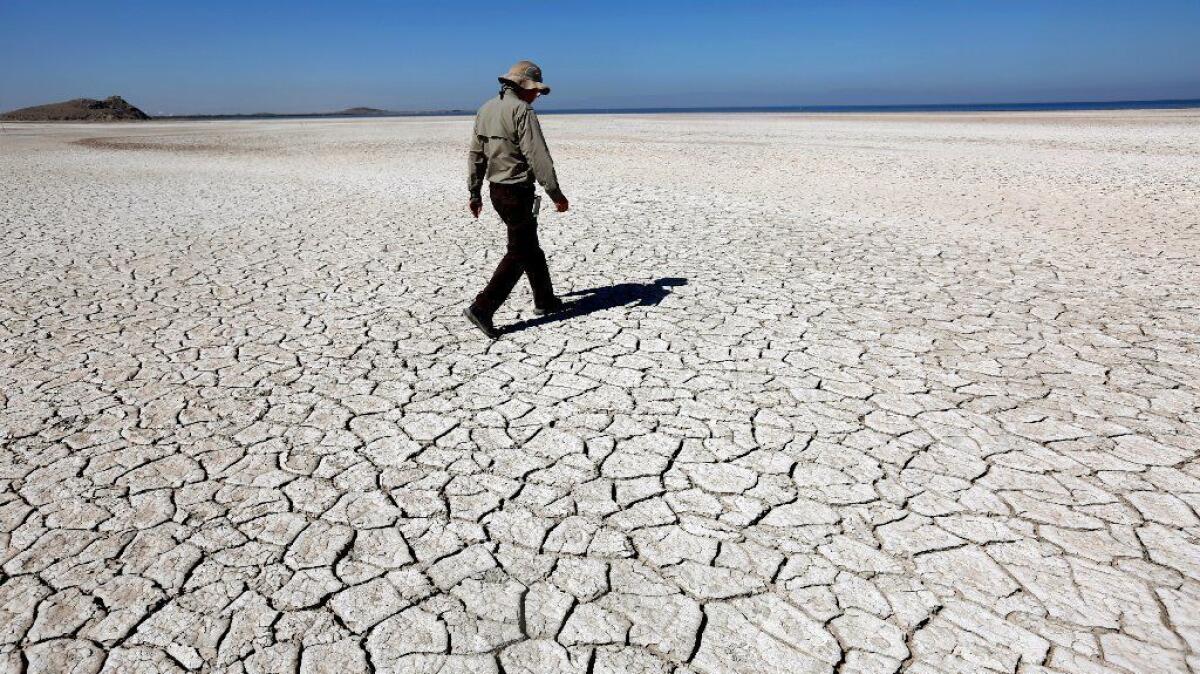State unveils a 10-year plan to restore habitat and control toxic dust storms along the Salton Sea’s receding shoreline

Salton Sea advocates on Thursday cautiously celebrated the announcement of a 10-year state plan to complete projects designed to restore areas where migrating birds once proliferated and control toxic dust storms rising off expanses of smelly playa surrounding the shrinking salty lake.
The California Natural Resources Agency said the plan aims to resolve disputes with the state over delays in building the 7-year-old projects that have left local policymakers and conservationists frustrated and angry as air quality and environmental conditions steadily worsen at California’s largest and most troubled lake.
For the record:
2:01 p.m. April 25, 2024An earlier version of this post misstated the salinity level of the Pacific Ocean as 35,000 parts per thousand. The ratio is 35 parts per thousand.
Those projects are regarded as the first phase of a proposed long-term Salton Sea restoration program. They include building a series of ponds and water-transfer systems across about 29,000 acres at a cost of about $383 million, officials said.
Last year, the state Legislature approved $80.5 million for Salton Sea projects.
The new plan, for the first time, details the number of acres of lake bed expected to become exposed each year from 2018 through 2028, the number of acres to be restored each year over the next decade through restoration projects, as well as how much those projects are expected to cost.
John Laird, California Secretary for Natural Resources, said the state is “committed not only to getting started quickly on these projects, but also to learning as we go and adjusting so that our future work is as efficient and effective as possible.”
Critics point out, however, that it remains unclear how the plan will be funded and whether the state can be held accountable if it fails to make good on its commitments to protecting public health and habitat at the 360-square-mile lake straddling Riverside and Imperial counties.
Officials said state, federal, regional, tribal and philanthropic agencies would continue to seek funding in their long-term effort to protect air quality and wildlife at the Salton Sea.
“The good news is that this plan identifies certain Salton Sea restoration projects and puts a price tag on them,” said Garrison Frost, a spokesman for California Audubon. “But we still need clarification on how the state will pay for them, as well as the overall Salton Sea problem, which is enormous.”
Sarah Friedman, a senior campaign representative for the Sierra Club, agreed.
“The 10-year plan is a real step forward,” Friedman said. “It is now incumbent on our state leaders to work together to provide the relatively minor resources and funding to avoid a $70-billion human health, ecological, and economic disaster.”
The projects were developed in 2010, when scientists warned that salinity would spike to 60 parts per thousand parts of water in 2017, imperiling fish and the birds that eat them.
Today, salinity levels at the Salton Sea are about 59 parts per thousand, federal reclamation authorities said. By comparison, the salinity level of the Pacific Ocean is about 35 parts per thousand.
The Salton Sea and surrounding valleys provide habitat for more than 400 species of birds — half the entire number of species to be found nationwide. One of the most important wetlands along the Pacific Flyway, the Salton Sea supports nearly 90% of the migratory route’s American white pelicans and 90% of its eared grebes.
The political turmoil at the Salton Sea began in 2003, when the state Legislature promised to halt, or at least slow, the shrinking of the lake as part of a successful effort to persuade the Imperial Irrigation District to sell some of its water to San Diego.
Under that agreement, the water district is required to send water into the sea until the end of 2017. With reductions of runoff just 10 months away, critics worry that a toxic brew of salt laced with pesticides and particulates small enough to be dangerous to human health will be picked up by the wind and dispersed across the communities of the neighboring Imperial and Coachella valleys.
In a 2012 event known as “the big burp,” Los Angeles County residents got a whiff of Salton Sea air scented by a massive fish die-off.
Rising salinity levels at the Salton Sea have been linked to massive die-offs of perch-like fish called tilapia, which huge populations of migrating birds birds including cormorants and pelicans depend on.
“This new plan shows some progress on the part of the state, but it remains very much a work in progress,” said Michael Cohen, co-author of a 2014 Pacific Institute report titled “Hazard’s Toll: The Costs of Inaction at the Salton Sea.”
Cohen was among a group of about 60 state lawmakers, wildlife authorities and other stakeholders who toured the Salton Sea on Thursday to take stock of the declining condition of its receding shorelines.
“We saw hundreds of acres of dry, dusty playa,” he recalled. “But not very many birds.”
“On the other hand, we’re witnessing the greatest interest yet on the part of state officials in the Salton Sea,” he said. “I’m hoping this time we see tangible progress on the ground.”
More to Read
Start your day right
Sign up for Essential California for news, features and recommendations from the L.A. Times and beyond in your inbox six days a week.
You may occasionally receive promotional content from the Los Angeles Times.







